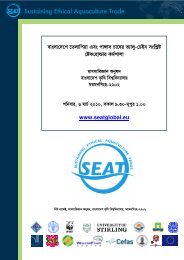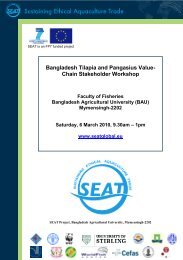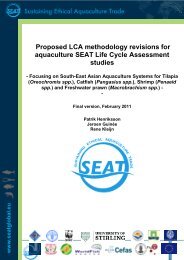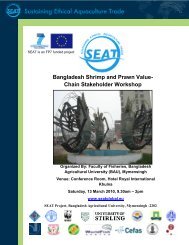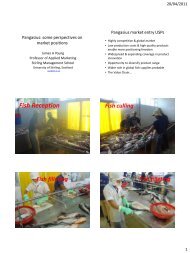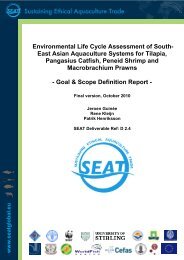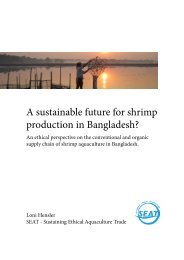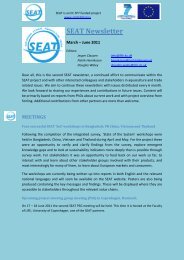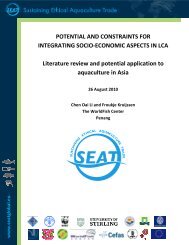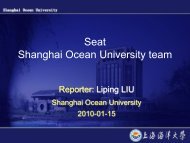D4.1 Review of Environmental Models - SEAT Global
D4.1 Review of Environmental Models - SEAT Global
D4.1 Review of Environmental Models - SEAT Global
You also want an ePaper? Increase the reach of your titles
YUMPU automatically turns print PDFs into web optimized ePapers that Google loves.
1.2.5 WASP<br />
January 1996 (Schneiderman et al., 2002). However, further development <strong>of</strong> GWLF has lead<br />
the USEPA to consider integrating this model within their BASIN Watershed Assessment<br />
Tools. (Schneiderman et al, 2002)<br />
The Vensim modelling package has been successfully linked with ArcGIS via Excel <br />
spreadsheets to model soil erosion and the related nutrient impact on the Keelung<br />
watershed in Taiwan (Yeh et al., 2006). Here five parameters were considered including soil<br />
erosion, sediment transport, run<strong>of</strong>f, nutrient flow and economic impacts (Yeh et al., 2006).<br />
The basic watershed characteristics were measured through ArcGIS and the system<br />
dynamics were carried out in Vensim. Excel spreadsheets were used to convert results<br />
produced from ArcGIS to inputs for the Vensim model and for storage <strong>of</strong> the resulting<br />
Vensim outputs (Yeh et al., 2006).<br />
WASP is an environmental modelling tool developed by the USEPA for water bodies (USEPA<br />
2010). The hydrodynamic aspect <strong>of</strong> the model utilises the Saint-Venant equations for<br />
variable flow (Vuksanovic et al., 1996). It is robust modelling system which can be used for<br />
simulations in water bodies as diverse as coastal and estuarine environments (USEPA, 2010).<br />
It simulates the transport <strong>of</strong> contaminants through surface waters (US EPA 2010) and while<br />
the results can be useful they are general and <strong>of</strong>ten not specific enough to make detailed,<br />
system specific management decisions (Schaffner et al, 2009).<br />
The WASP program has been widely used for estuarine systems throughout the world<br />
(USEPA, 2010). The program is simple to use and can easily integrate data from<br />
hydrodynamic and sediment transport models (USEPA, 2010). The post-processing facility<br />
provides two data displays: the first giving a spatial modelled outputs for each parameter,<br />
and the second graphical showing concentrations over time to illustrate general trends for<br />
comparison with empirical data (USEPA, 2010). WASP has been used effectively for “realtime”<br />
development <strong>of</strong> management strategies for the ‘Little River embayment in Lake<br />
Allatoona, Georgia’ (US EPA, 2010). The model was tested in an estuary in Belgium to<br />
simulate the flow <strong>of</strong> PCBs at that particular time in the estuary. The WASP has also been<br />
used to simulate the flow and spatial distribution patterns <strong>of</strong> PCBs in a Belgian estuary. The<br />
simulation included transport and sorption rates <strong>of</strong> the isomers studied to sediment<br />
particles (Vuksanovic et al., 1996). Comparison to measured levels <strong>of</strong> PCBs showed a clear<br />
correlation between high <strong>of</strong> PCBs and areas <strong>of</strong> enhanced turbidity, agreeing with the<br />
hypothesis that sorption <strong>of</strong> PCBs correspond to levels <strong>of</strong> particulate materials and resulting<br />
in an effective simulation model (Vuksanovic et al., 1996). The eutrophication function <strong>of</strong><br />
WASP was used to determine nutrient transport and cycling to attempt to determine how to<br />
reduce the nutrient loading on the estuary (Wool et al., 2003). The performance statistics<br />
found the model to simulate the system nutrient dynamics and predict the water quality<br />
accurately (Wool et al., 2003).<br />
The WASP model was designed to be highly adaptable where users have the opportunity to<br />
customize sub routines for different aquatic systems (USEPA, 2010). Parameters and state<br />
variables can be added, removed and modified to fit to a system where the user has a<br />
detailed knowledge <strong>of</strong> environmental interactions (Ward Jr & Benaman, 1999).<br />
When using WASP, external hydrodynamic tools can be avoided by incorporating the flow<br />
data directly in the program using a link to other models such as the companion<br />
Page 9



